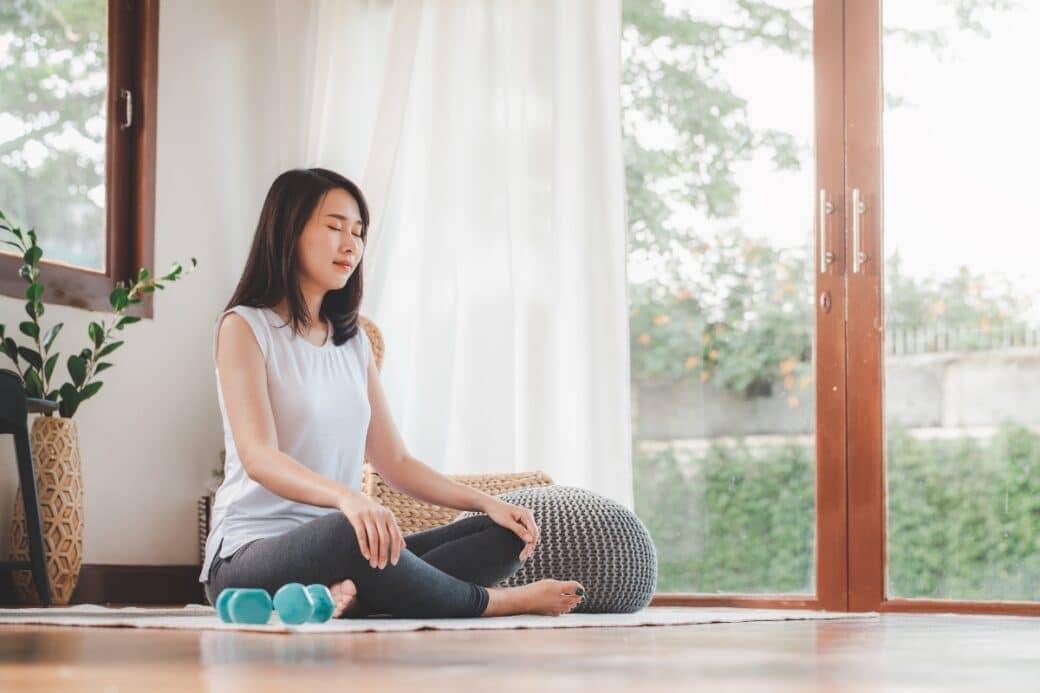In today’s fast-paced world, finding moments of peace and clarity can often feel like an impossible task. That’s why many people turn to guided meditation as a way to enhance mindfulness and cultivate a sense of inner calm. But does guided meditation really work? This article explores the effectiveness of guided meditation in helping individuals achieve a state of mindfulness, and how it can positively impact both mental and emotional well-being. Get ready to embark on a journey of self-discovery and uncover the transformative power of guided meditation.
Understanding Guided Meditation
Definition of guided meditation
Guided meditation refers to a form of meditation where an experienced practitioner or a meditation teacher guides individuals through the meditation process. It involves following verbal instructions or listening to pre-recorded audio to help focus the mind, relax the body, and achieve a deeper state of meditation. In this form of meditation, the guidance provided serves as a support system to enhance the overall meditation experience.
The structure of guided meditation
Guided meditation typically follows a structured format that helps individuals navigate through the meditation process. It begins with finding a comfortable and quiet space, assuming a relaxed posture, and focusing on the breath. The guide then introduces various techniques such as visualization, body scans, or affirmations, which aid in deepening the meditation practice. The session concludes with a gradual return to the present moment and a mindful reflection on the experience.
Different types of guided meditation
There are several different types of guided meditation, each with its own unique style and focus. Some common types include:
- Mindfulness Meditation: This type of guided meditation focuses on cultivating awareness and non-judgmental attention to the present moment.
- Loving-Kindness Meditation: Also known as Metta meditation, this practice involves directing feelings of love, compassion, and goodwill towards oneself and others.
- Progressive Muscle Relaxation: This guided meditation technique involves systematically tensing and relaxing different muscle groups to promote physical and mental relaxation.
- Visualizations: Guided meditations that incorporate visualizations guide individuals through mentally creating images or scenarios to enhance relaxation and focus.
- Body Scans: This type of guided meditation involves systematically scanning and bringing attention to different parts of the body to cultivate body awareness and relaxation.
Understanding the different types of guided meditation allows individuals to choose a practice that aligns with their personal needs and goals in meditation.
The Importance of Mindfulness
Defining mindfulness
Mindfulness can be defined as the practice of intentionally bringing one’s attention to the present moment without judgment. It involves cultivating a non-reactive, non-judgmental awareness of one’s thoughts, emotions, and sensations. Mindfulness encourages individuals to observe their experiences as they arise and pass, fostering a deeper understanding of oneself and the world around them.
The role of mindfulness in daily life
Mindfulness has become increasingly important in today’s fast-paced and highly stressful world. By cultivating mindfulness, individuals can develop a greater capacity to handle stress, navigate difficult emotions, and make conscious choices in their daily lives. It helps to shift our focus from dwelling in the past or ruminating about the future, and instead, empowers us to fully engage with the present moment, leading to a more balanced and fulfilling life.
Health benefits of mindfulness
Numerous studies have shown that mindfulness practice offers a wide range of health benefits. Regular practice of mindfulness has been linked to reduced stress, anxiety, and depression. It has also been shown to improve cognitive abilities, such as attention and memory, and enhance overall psychological well-being. Additionally, mindfulness has been found to have positive effects on physical health, including reducing blood pressure, boosting the immune system, and enhancing sleep quality.

Role of Guided Meditation in enhancing Mindfulness
Connection between mindfulness and meditation
Mindfulness and meditation are closely intertwined. Meditation serves as a primary means of cultivating mindfulness by training the mind to remain focused and present. Guided meditation, in particular, plays a significant role in enhancing mindfulness as it provides a structured framework for individuals to develop their mindfulness practice. By following the guidance of an experienced practitioner, individuals can deepen their understanding of mindfulness and integrate it into their daily lives more effectively.
How guided meditation fosters mindfulness
Guided meditation acts as a bridge between the practice of mindfulness and its application in daily life. During guided meditation, individuals receive step-by-step instructions and support to anchor their attention in the present moment. The guiding voice helps to gently bring awareness back whenever the mind wanders and encourages non-judgmental observation of thoughts, emotions, and sensations. This repeated guidance and practice in meditation sessions gradually fosters the development of mindfulness skills.
Practical examples of mindfulness through guided meditation
Guided meditation provides practical examples and exercises to help individuals cultivate mindfulness in various aspects of life. For example, during a guided meditation session, individuals may be guided to bring mindful awareness to everyday activities such as eating, walking, or even brushing their teeth. These exercises serve as reminders to slow down, pay attention to the present moment, and cultivate a sense of gratitude and non-judgment towards everyday experiences.
Scientific Evidence on the Effectiveness of Guided Meditation
Research on guided meditation and mindfulness
Scientific research has shown promising results regarding the effectiveness of guided meditation in enhancing mindfulness. A study published in the Journal of Psychiatric Practice demonstrated that individuals who practiced guided mindfulness meditation experienced reduced symptoms of anxiety and depression compared to control groups. Another study conducted at the University of California, San Francisco revealed that guided meditation led to improvements in attention, memory, and emotional regulation.
Physiological benefits of guided meditation
Guided meditation has been shown to have several physiological benefits. Research conducted at Harvard Medical School found that regular meditation practice can reduce the activation of the amygdala, a part of the brain associated with the stress response. This reduction in stress response leads to a decrease in cortisol levels and a greater sense of calm and relaxation. Additionally, studies have shown that guided meditation can improve heart health, lower blood pressure, and boost the immune system.
Psychological benefits of guided meditation
Guided meditation has also been linked to numerous psychological benefits. A meta-analysis published in JAMA Internal Medicine found that mindfulness meditation, including guided meditation, can significantly reduce symptoms of anxiety and depression. It has also been found to enhance emotional well-being, increase resilience, and improve overall psychological functioning. Additionally, guided meditation has been shown to promote better sleep and enhance self-compassion and self-awareness.
Myths and Misconceptions about Guided Meditation
Common myths about guided meditation
Despite the growing popularity of guided meditation, there are several common myths and misconceptions surrounding this practice. One common myth is that guided meditation is only for beginners or those who are new to meditation. In reality, guided meditation can benefit individuals at any experience level, providing guidance and support throughout their meditation journey.
Another misconception is that guided meditation requires complete silence and a perfectly calm mind. While a quiet environment can enhance the meditation experience, it is not a requirement. Guided meditation helps individuals navigate distractions and thoughts that arise during the practice, allowing for a more accessible and enjoyable experience.
Addressing misconceptions about meditation and mindfulness
It is essential to address misconceptions about meditation and mindfulness to encourage individuals to fully embrace these practices. Meditation is not about achieving a thoughtless state or immediate enlightenment. Instead, it is about cultivating awareness and acceptance of one’s thoughts and experiences. Mindfulness is not about eliminating negative emotions but rather fostering a compassionate and non-judgmental relationship with them.
By dispelling these misconceptions, individuals can approach guided meditation with an open mind and embrace the benefits it offers.
Benefits vs expectations in guided meditation
Setting realistic expectations is crucial when starting a guided meditation practice. It is important to recognize that the benefits of guided meditation are cumulative and may not be immediate. Regular and consistent practice is key to experiencing the full potential of guided meditation. It is also essential to remember that guided meditation is a personal journey, and each individual may have different experiences and outcomes. Approaching guided meditation with an open and curious mindset allows individuals to fully engage with the practice and discover its unique benefits for themselves.
The Process of Guided Meditation
How to do guided meditation
To get started with guided meditation, follow these steps:
- Find a comfortable and quiet space where you won’t be interrupted.
- Settle into a relaxed posture, either sitting or lying down.
- Close your eyes or soften your gaze.
- Choose a guided meditation recording or find a meditation app that suits your preferences.
- Follow the instructions provided by the guide, focusing on your breath, sensations, or visualization.
- Whenever your mind wanders, gently bring your attention back to the guidance.
- Allow yourself to fully immerse in the experience and observe without judgment.
- After the guided meditation session, take a moment to reflect on your experience and notice any shifts in your state of mind or body.
Ideal conditions for guided meditation
While guided meditation can be practiced anywhere, creating an ideal environment can enhance the overall experience. Choose a space that is quiet, free from external distractions, and comfortable. Eliminate any potential interruptions by turning off notifications on your phone or using a “Do Not Disturb” mode. Consider using ambient lighting, soft music, or aromatherapy to create a calming atmosphere. However, it is essential to remember that the perfect conditions are not necessary to practice guided meditation. Adapt the practice to your surroundings and make the most of the resources available to you.
Duration and frequency of guided meditation sessions
The duration and frequency of guided meditation sessions can vary based on individual preferences and schedules. It is recommended to start with shorter sessions, such as 5 to 10 minutes, and gradually increase the duration as you become more comfortable with the practice. Many individuals find it beneficial to incorporate guided meditation into their daily routine, setting aside a specific time each day for their practice. Consistency is key, so find a schedule that works for you and commit to regular practice.
Common Challenges in Guided Meditation
Difficulty focusing during guided meditation
One common challenge individuals may face during guided meditation is difficulty maintaining focus. The mind has a tendency to wander, especially when first starting meditation. However, this is a normal part of the practice, and with time and patience, focus can be improved. When you notice your mind wandering, gently redirect your attention back to the guidance and the present moment. Utilize the guidance provided in the meditation to anchor your attention and bring yourself back whenever distraction arises.
Managing physical discomfort during meditation
Physical discomfort can also be a challenge during guided meditation, especially if sitting for an extended period or assuming a posture that is not comfortable. It is important to find a posture that allows for both alertness and relaxation. If sitting cross-legged is uncomfortable, try sitting on a meditation cushion, using a chair, or even lying down. Incorporating gentle stretches or movements before meditation can also help alleviate physical discomfort and prepare the body for stillness.
Dealing with emotional distress during meditation sessions
Meditation can sometimes bring up unresolved emotions or feelings of discomfort. It is crucial to approach these experiences with self-compassion and without judgment. Allow the emotions to arise, acknowledging them without getting caught up in the stories or judgments associated with them. If needed, seek support from a qualified therapist or meditation teacher who can guide you through processing and understanding any emotional distress that may arise during your practice.
Advanced Guided Meditation Techniques
Progressing in guided meditation practice
As individuals become more familiar with guided meditation, they may wish to explore advanced techniques to deepen their practice. Some advanced guided meditation techniques include:
- Breathwork: Guided meditation sessions can focus on more intricate breathwork techniques, such as alternate nostril breathing or box breathing.
- Mantra Meditation: Introducing repetitive sounds or phrases, known as mantras, can deepen the meditative experience and focus the mind.
- Insight Meditation: Advanced guided meditation can incorporate insight or vipassana meditation, which involves observing the nature of thoughts, sensations, and emotions.
By gradually incorporating these advanced techniques, individuals can continue to progress in their guided meditation practice and cultivate deeper levels of mindfulness.
Advanced meditation techniques for increased mindfulness
Advanced guided meditation techniques aim to cultivate increased mindfulness and self-awareness. These techniques often involve exploring more subtle sensations, thoughts, and emotions. One example of an advanced technique is body scanning, where individuals bring their attention to specific body parts in a systematic way, gradually increasing their ability to observe minute sensations. Another example is open monitoring, where individuals observe the flow of thoughts and emotions without getting attached or identified with them. These techniques can strengthen mindfulness and enhance one’s ability to develop a non-reactive and accepting attitude towards their inner experiences.
Adapting your guided meditation practice over time
As individuals continue their guided meditation practice, it is essential to adapt and modify the practice to meet their evolving needs. This may involve exploring different types of guided meditation, experimenting with different teachers or apps, or incorporating new techniques into the practice. It is also important to periodically reassess one’s goals and intentions for meditation to ensure they align with personal growth and development. Embracing flexibility and allowing the practice to evolve with you can lead to a more enriching and fulfilling guided meditation experience.
How to choose a Guided Meditation Program
Factors to consider when choosing a guided meditation program
When selecting a guided meditation program, considering the following factors can help ensure a suitable fit:
- Experience Level: Consider whether the program caters to beginners, intermediate practitioners, or more advanced meditators.
- Style and Technique: Different programs offer varying styles and techniques, so choose one that aligns with your personal preferences and goals.
- Teacher Qualifications: Look for programs led by experienced and qualified meditation teachers who have a deep understanding of mindfulness and meditation techniques.
- Length and Format: Consider the duration of the guided meditations and whether they fit into your schedule. Additionally, determine if you prefer pre-recorded sessions, live sessions, or a combination of both.
By considering these factors, you can find a guided meditation program that resonates with you and supports your mindfulness journey effectively.
Understanding your personal mindfulness goals
To choose the most suitable guided meditation program, it is important to clarify your personal mindfulness goals. Reflect on why you want to incorporate guided meditation into your life and what specific areas you wish to address. Whether it’s stress reduction, improved focus, or emotional well-being, having a clear understanding of your intentions will guide you in selecting a program that aligns with your goals.
Reviews and recommendations for guided meditation programs
Reading reviews and seeking recommendations from others who have experienced guided meditation programs can provide valuable insight and guidance. Online platforms, meditation communities, or even friends and family can offer recommendations based on their personal experiences. Additionally, reading reviews and testimonials on websites, apps, or social media platforms can help you gain a better understanding of the program’s quality and effectiveness.
Best Practices for Effective Guided Meditation
Creating the right environment for guided meditation
To create an optimal environment for guided meditation, consider the following best practices:
- Find a quiet space where you can minimize external distractions.
- Ensure the space is comfortable and free from excessive physical discomfort.
- Set aside dedicated time for your practice to avoid feeling rushed.
- Consider using props or tools that enhance relaxation, such as cushions, blankets, or an eye mask.
- Use ambient lighting or soothing fragrances to create a calming atmosphere.
By implementing these practices, you can cultivate an environment that supports deep relaxation and focused attention during guided meditation.
Incorporating mindfulness techniques into daily routines
Enhancing mindfulness extends beyond the guided meditation practice itself. Integrate mindfulness techniques into your daily routines by bringing a mindful presence to everyday activities. Whether it’s mindful eating, mindful walking, or even mindful listening, find opportunities throughout the day to anchor your attention in the present moment and cultivate a non-judgmental awareness.
Overcoming common obstacles in guided meditation practice
Guided meditation practice can sometimes be challenging, but overcoming common obstacles is possible with perseverance and patience. Here are some strategies to overcome common challenges:
- Lack of motivation: Remind yourself of the benefits of guided meditation, set realistic goals, and seek support from a meditation group or community.
- Inconsistency: Establish a regular meditation routine by scheduling dedicated time for your practice in your daily or weekly schedule.
- Restlessness or boredom: Experiment with different types of guided meditations or techniques to keep your practice fresh and engaging.
By recognizing and addressing these obstacles, you can maintain a consistent and fulfilling guided meditation practice.
In conclusion, guided meditation offers a structured and supportive approach to enhance mindfulness in daily life. By understanding the definition, structure, and various types of guided meditation, individuals can begin their journey towards greater self-awareness. Scientific evidence supports the effectiveness of guided meditation in improving overall well-being, both physically and psychologically. Addressing myths and misconceptions helps individuals approach guided meditation with realistic expectations and reap its benefits fully. By following best practices, overcoming challenges, and exploring advanced techniques, individuals can deepen their mindfulness practice and experience the transformative power of guided meditation. Finally, choosing the right guided meditation program, aligning it with personal goals, and incorporating mindfulness into daily life can lead to a more mindful and fulfilling existence. So why wait? Start exploring guided meditation today and unlock the potential of a more present, peaceful, and purposeful you.




